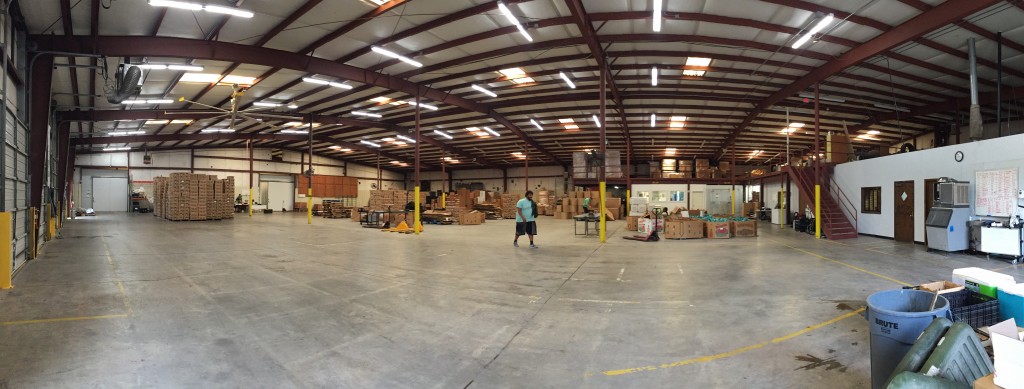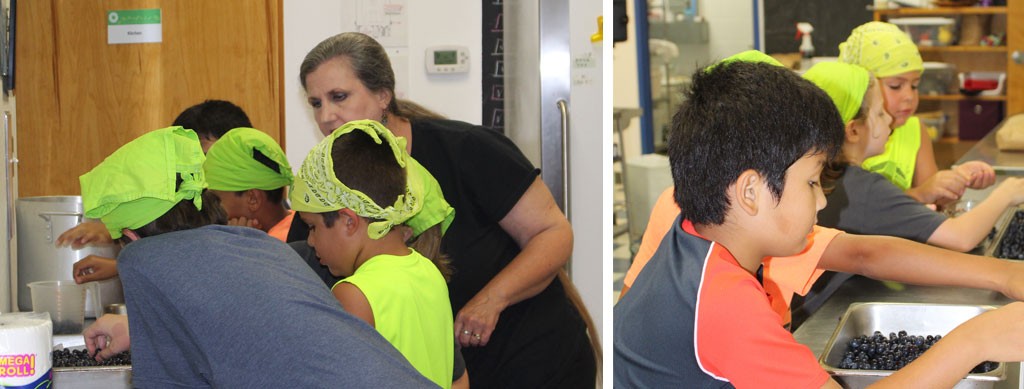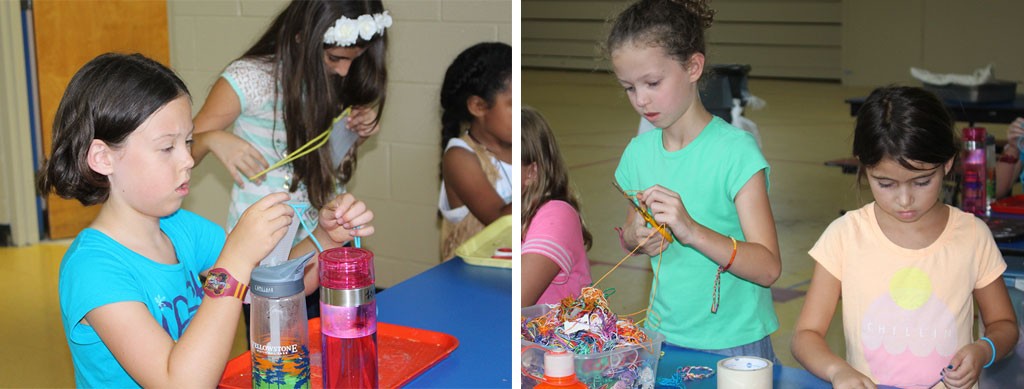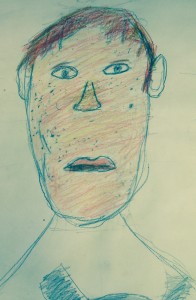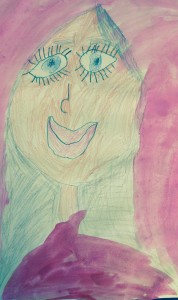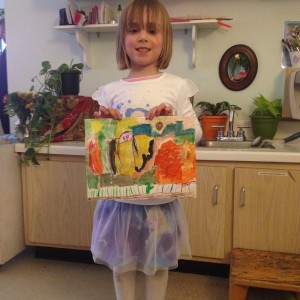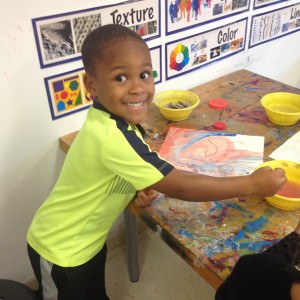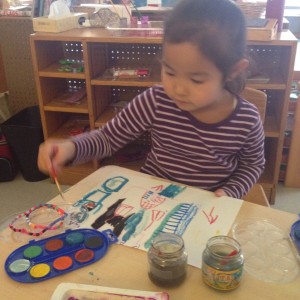
Primary sweet potato biscuits keep students warm on a cold morning.
At Greensboro Montessori School, Environmental Education Curriculum is based on seasonal cycles, the outdoor environment at the School, and the age of the students. We invite spontaneity and often pause to watch and identify insects, marvel at life in the garden, and discuss questions or insights as a community. In all levels we teach about soil, decomposition and compost, pollination, and biodiversity. But what is it we do in winter when the gardens are resting? The short answer is, we teach seasonality and ecology in organic gardens.
Primary students study birds, concentrating on basic identification by sight and sound. They love making binoculars (out of recycled toilet paper rolls) and using them on our bird walks around campus. Along the way, they learn to empathize with birds and their needs, to stop and slow down as not to miss a moment of wonder, and to make an ecological connection between our gardens and the needs of birds: shelter, food, water, and spaces to nest. As the weather warms up, we explore our winter stores of food from the fall gardens - sweet potatoes, garlic, ginger, and honey - in cooking classes, and venture outdoors to observe and relish in the signs of spring!
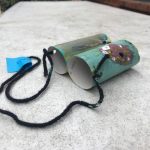
Lower Elementary students' binoculars are treasured tools in class this month.
Lower Elementary students delve even deeper into their bird study, concentrating not only on the basic identification of birds, but also on prolonged observation of bird behavior, habitat, and appreciation for their ecological significance in our organic, permaculture gardens. They love learning how to use and read field guides like ornithologists! I find bird study with this age is a wonderful way to remind children how to sit and soak in the surrounding environment, something we often don’t take time to do when the garden gets growing in spring. Bird watching in winter offers students opportunities to experience peace, critical thought, and insight that they so desperately need after the holiday rush and just before the end of year crunch! As spring break draws near, we share our bird findings with area scientists, cook with our winter food stores, and begin preparing ourselves for spring planting in the garden.
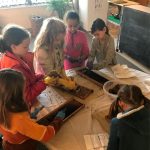
Upper Elementary students save bees wax from a hive that died over the winter. Honey bees and other native bees are a focal point for these students' climate change project.
Upper Elementary winter studies range from native tree and animal projects to redesigning of our Upper School outdoor classroom. This year, we're up to something BIG ... we’re tackling the subject of climate change and how it affects each of us and our experience at Greensboro Montessori School. We're thrilled the culmination of this project will include an art installation we collectively create and participation at the Student Climate Change Summit at UNCG on March 29. The event will be from 5 to 8 p.m. at Weatherspoon Art Museum. Open to the public, the Student Climate Change Summit will feature a wide-array of student participants representing several generations. In addition to our Upper Elementary students presenting their artwork, undergraduate students from UNCG will present research posters around a variety of climate change topics. A student from NC State will describe the work of The Climate Reality Project Campus Corps on their campus. Last but not least, students from the International Baccalaureate (IB) Program at Grimsley High School will present posters highlighting their IB papers on climate change. We hope you will join us at Weatherspoon Art Museum on March 29!
 About the Author
About the Author
Eliza Hudson is Greensboro Montessori School's lead environmental educator. Eliza holds her bachelor's degree in biology from Earlham College in Richmond, Ind. She has built and tended school gardens, taught hands-on cooking lessons and connected local farms to school programs working for FoodCorps. Prior to joining Greensboro Montessori School in 2014, Eliza was a classroom and after-school assistant at the Richmond Friends School, a farm intern at a family-owned farm in Ohio, and served as assistant director at a summer day camp in an urban community garden in Durham.
Greensboro Montessori School has taught environmental education since 1995 and has been permaculture gardening on its campus since 1997.
In 2005, Greensboro Montessori School eighth graders first traveled to Costa Rica for a cultural immersion experience. We were eager to connect with another Montessori school abroad with a similar adolescent program. Our research led us to The Summit School in Coronado, Costa Rica which is very close to the capital city of San José. On our first expedition to Costa Rica, we incorporated a formal school visit to The Summit School and it was the highlight of our trip. The parents made a special lunch for us, and our students assisted the younger Costa Rican children with a school project. When we returned the following year, students from The Summit School accompanied our students in our daily travels and service learning adventures. At that point, Greensboro Montessori School and The Summit School became sister schools.
Since then, the eighth grade trip to Costa Rica has morphed into an authentic immersion experience. Our students stay with the Costa Rican families of The Summit School students, and together, our students and the Ticos (a colloquial term for natives of Costa Rica) go everywhere together. We visit volcanoes, complete high ropes courses and sail through the rainforest canopy on zip lines. We travel to the Caribbean Coast where we walk the beach at night looking for turtle eggs to bury in a nearby protected hatchery. We travel to the Pacific side to snorkel and explore rain forests and animal sanctuaries. We spend a day in downtown San José learning about Costa Rican history, art, and government. Our weekends are spent with the host families doing what they usually do. The students also do things you would expect them to do on the weekends: they get together and go to the mall or a movie or a party at someone’s home.
Every year, when asked what our students’ favorite part of the trip is, they always say their homestay with the Tico families. Our students make friendships that last for years, and some even return to Costa Rica on their own to visit their “families.”
In 2009, the Ticos first ventured to Greensboro Montessori School to stay with our students and learn more about North Carolina. Even though we don’t have erupting volcanoes or zip lines through the rain forest, we still have a great time sharing the landmarks and natural wonders of our state with them. Our visits have included such destinations as the Duke Lemur Center, the North Carolina Museum of History, and Hanging Rock State Park. On a recent visit, our itinerary included kayaking on the Dan River, exploring Grandfather Mountain, and a tour of the Duke University Marine Lab in Beaufort. Our homestay hosts always arrange social gatherings for the students on the weekends. The Ticos typically experience some classroom time with us as well as a trip to The Land in Oak Ridge.
Our students benefit tremendously from the life-changing experiences resulting from our relationship with The Summit School. With every visit to Costa Rica, our students return with their eyes a little wider and their lives a little richer as they have their first experience actually living in another culture. They begin to see the world in a different light and develop a new appreciation for the abundance in their lives.
If you stroll through our school gardens on any given Monday afternoon, you are likely to find Marcia Jones volunteering alongside our lead environmental educator, Eliza Hudson. As a retired educator, Marcia looks forward to her weekly gardening class with our Primary students, and with her 31 years of experience as a kindergarten teacher in Guilford County, we look forward to all she has to offer the children and the school. In a recent interview, Marcia shared with us how much she loves teaching young children the value of tending the earth, especially her four grandchildren including Foster, who is enrolled in our Primary program.
In addition to helping in our gardens on a weekly basis, Marcia supports several other community gardening projects in and around the Greensboro area. She uses her green thumb to tend the gardens at the Wentworth Museum in Rockingham County, the Guilford College Community Garden and Jones Elementary School. “Gardening helps me relax,” Marcia shared, "and its so nice to be able to see the product of all your effort. I think that’s especially true for young children." Many years ago, she started a gardening program with her kindergarten students at Sedgefield Elementary School. “The children loved it. We grew a wide variety of vegetables from seed, including squash, radishes, potatoes, peas, and pumpkins. The children especially liked the pumpkins because they would grow all summer and could be harvested in the fall,” she shared.
With her family’s roots in this area of North Carolina, Marcia is deeply connected to the land, and her knowledge of farming is much greater than what her humble demeanor might initially suggest. She grew up working on her family's farm in Rockingham County just north of Greensboro and she has many fond memories of driving the tractor out in the fields. “My sister and I were working on the family farm up until two years ago. Over the years, we’ve grown tobacco, corn, wheat, soybeans and apples.” Even with those years of experience in her back pocket, Marcia continues to express her modesty about having a green thumb and loves learning new gardening techniques from those around her. “Lately, I’ve been learning more about which herbs to plant around my vegetable garden to deter deer and other wild animals,” she told us.
We recently began a discussion on the quintessential similarities between computational thinking and the Montessori method. The three-part blog series is inspired by a recent New York Times article by Laura Pappano entitled “Learning to Think Like a Computer.” In our first post, we explained how even the simplest of Montessori materials teaches computational thinking skills. In this second installment, we highlight how the Montessori approach to education develops computational thinking within students.
We met with Jonathan McLean to talk about his semester-long assignment in the Middle School’s Creative Labs course. Like all classes in the Montessori curriculum, this visual and performing arts class integrates subject matter from other areas of study. More specifically, Jonathan is weaving together STEM (Science, Technology Engineering and Math) and Art History through a complex science fiction role-playing game involving student-built robots and drones. To make sense of the story and succeed in the game, Jonathan’s students must employ computational thinking skills.
Just what are these skills? In her New York Times article, Laura Papanno says they are “recognizing patterns and sequences, creating algorithms, devising tests for finding and fixing errors, reducing the general to the precise and expanding the precise to the general.”
Our middle school students are flexing all these mental muscles in a battle royale between the Drones and the Bots, the only remaining cultures in the elaborate story guiding this semester’s coursework. The setting is such: The Earth has overheated making it inhabitable for organic life. Only two warring cultures, Bots and Drones remain, but neither are safe. Volcanic activity threatens the Bots on land and atmospheric change jeopardizes the Drones in air. The Bots and Drones must appeal to an Alien culture to save them, and it just so happens the Aliens have tremendous reverence for the visual arts. As the Bots and Drones compete for the Aliens’ benevolence, they must do so with aesthetically appealing design and decoration which aligns with the Aliens’ favorite artistic movements.
As the facilitator, Jonathan plays the role of the Alien culture. The students are divided into multi-age teams aligned with either the Bot or Drone culture. Jonathan gives the students data sets with which to design, build and operate their Bots and Drones. The teams consist of students in the various rolls such as officer, designer, engineer and pilot. As the students receive, process and make sense of the data they receive, they must adapt to survive. Whether either or both cultures escape the Earth will be determined in a three-hour Bot versus Drone showdown next week. The teams’ performances are the students’ final exam for the class (and Jonathan has a surprise finale planned for the students if they find a win-win solution for the Bots and the Drones).
Rather than dictate or force rote memorization upon their students, Montessori teachers educate through integrated experiences. Jonathan has created a fictional and engaging theme to provide a framework in which the students are able to apply real-world skills. Students are absorbing data from multiple sources to identify problems, understand the scope of the problems and develop and test solutions. Additionally, Jonathan is purposefully withholding information forcing the students to uncover new information and draw conclusion on their own. Harkening back to Laura Pappano’s words about computational thinking: “Concealing layers of information makes it possible to get at the intersections of things, improving aspects of a complicated system without understanding and grappling with each part. Abstraction allows advances without redesigning from scratch.”
If all of this sounds like a lot of fun, it is. Our middle school students are learning science, technology, engineering and math in their visual and performing arts class. If a student loves art, he can pursue this interest through the final appearance of his Drone, but he must also ensure aesthetic enhancement doesn’t impact physical performance. On the contrary, if a student loves engineering, she can fuel her curiosity through building her Bot, but the structure must accommodate one of the Aliens’ preferred art movements, for instance, Cubism.
In most schools throughout the country, these two students couldn’t thrive in the same class, but the Montessori method demands they both succeed by allowing them to pursue their passions through integrated curriculum and independent study. No single class takes place in a vacuum of learning, and students must carry their knowledge and experiences from one class to another. Ultimately, it’s learning how to think (like computational thinking skills), versus what to think which prepares these students for a lifetime of achievement.
A professional artist and entrepreneur in her own right, Madeline Gallucci is a nothing less than a rising star in the Kansas City art scene.
After graduating from Greensboro Montessori School in 2004 and Weaver Academy in 2008, Madeline received her Bachelor of Fine Arts from the Kansas City Art Institute in 2012. Shortly thereafter, she landed the Charlotte Street Foundation Urban Culture Project Studio Residency. Two years later she was named Artist-in-Residence at Hotel Phillips, a historic hotel in the center of the city. The 12-month program showcased Madeline and her work in a large storefront window space on the first floor of the hotel that doubled as her studio. Her artwork was also translated into textile patterns used in interior design elements—such as bedding, upholstery, pillows, curtains and wall art—in some of the guest rooms. She also conducted numerous workshops, studio tours and artist lectures. Madeline was only the fourth artist to be selected for this elite residency program and notes: “It was a tremendous opportunity to develop my public speaking skills. In essence, I was acting as an ambassador for abstract art.”
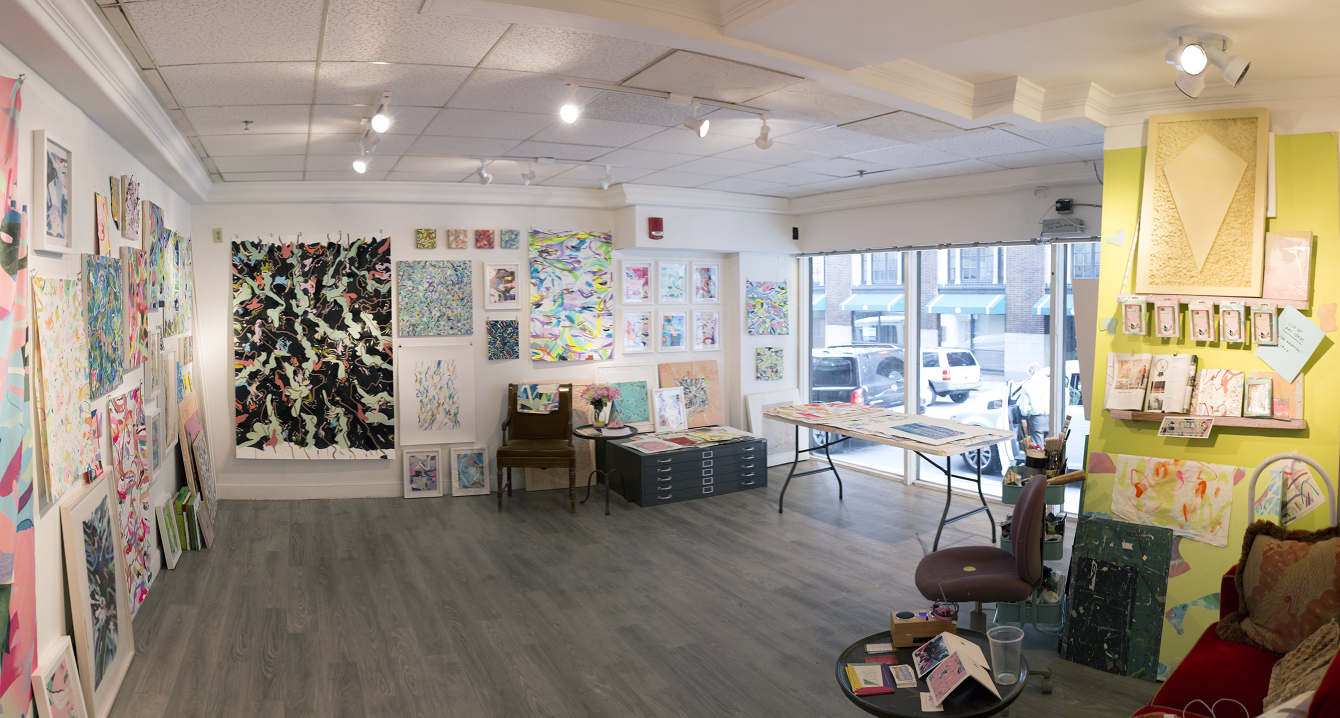
Madeline Galluci's studio gallery at Hotel Phillips. The program offered an experimental and collaborative opportunity for Madeline, the hotel, guests from all over the world, and the local Kansas City community.
As if two residencies weren’t enough to celebrate, Madeline was named one of three Charlotte Street Foundation Visual Artist Award Fellows in 2016. The award recipients were selected through a competitive process involving in-person interviews, presentations and studio visits by a panel of renowned and qualified arts professionals, and culminated in a four month exhibition that concluded in January 2017 at the Kemper Museum of Contemporary Art, Crossroads location. She also received a $10,000 unrestricted grant to support her work as an emerging contemporary artist. Madeline described this exhibition as a turning point in her life and her career. As a result of that award, she sought representation by a professional firm, Weinberger Fine Art in Kansas City, Missouri.
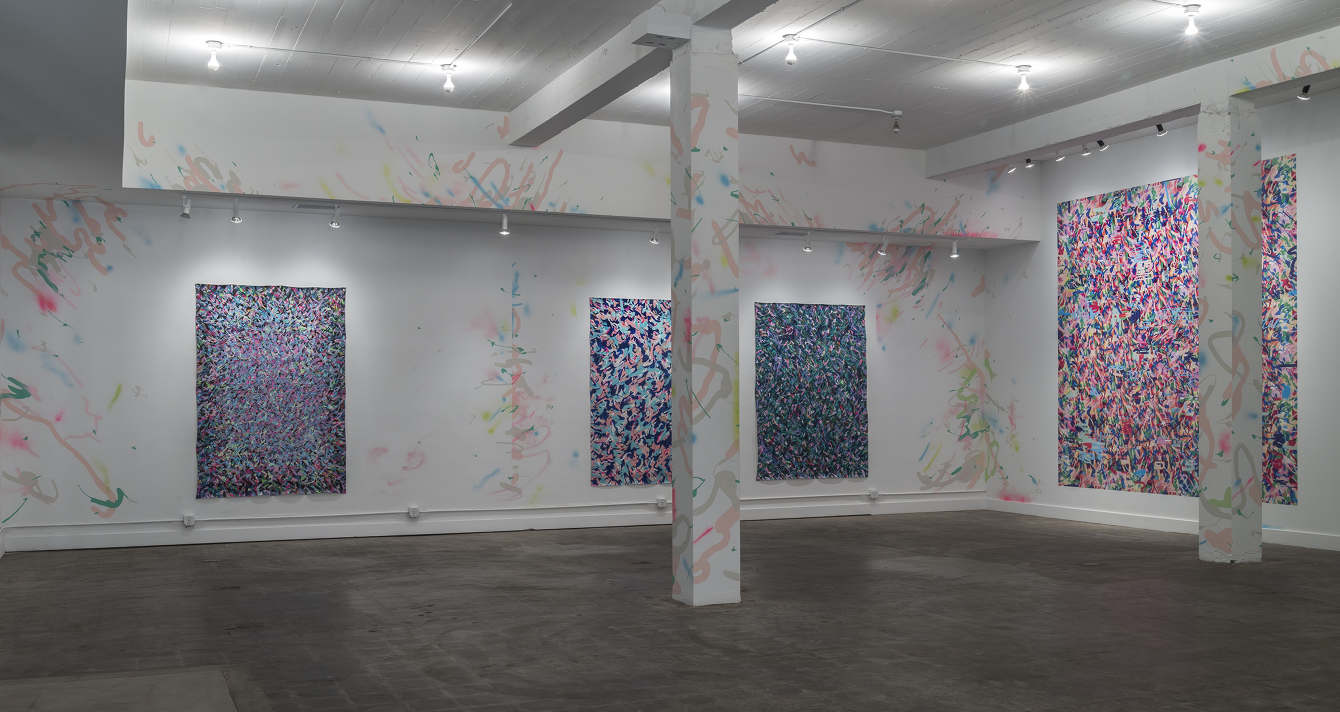
Madeline's work while on display at the 2016 Charlotte Street Foundation Visual Artist Awards Exhibition at the Crossroads location of the Kemper Museum of Contemporary Art. Photo by Misha Kligman.
When asked to describe her work, Madeline says, “My work is driven by color. Right now, I am playing with the combination of fluorescent colors together with colors found in nature. My work is also very whimsical. I am fascinated by camouflage culture. If the purpose of camouflage is to help something blend in to its environment, what happens when you take that pattern out if its natural environment. How does it blend in or stand out? I think of the trend of pink camouflage."
Beyond the borders of Kansas City, Madeline has also shown nationally at IDIO Gallery in Brooklyn, New York; Rebekah Templeton in Philadelphia, Pennsylvania; Skylab Gallery in Columbus, Ohio; and Terrault Contemporary in Baltimore, Maryland. Her newest work is currently on display in an exhibit entitled “Habitual Observations” at Weinberger Fine Art.
In addition to pursuing her professional goals through a fine art studio track, Madeline shared that she is also realizing her drive to become an arts administrator. Since 2014, she has worked as a co-director of Front/Space, a storefront apartment in downtown Kansas City that has been repurposed for non-commercial exhibits, performances, forums, research and publishing projects.
As co-director of the gallery, Madeline loves fostering a spirit of collaboration. She works closely with past exhibitors to review proposals for new artists who want to use the live/work studio and gallery space (which is supported by funding from the Robert Rauschenberg Foundation, the Charlotte Street Foundation and the University of Kansas' Spencer Museum of Art). "I love that the momentum comes from the artists themselves. I don’t want the gallery to just be the artwork that I or my partner would curate. It is important to me that we curate through an open call to the community.” The other element of the Front/Space mission that resonates for Madeline is the connection to social justice. “Front/Space is a safe space for artists and people who have been marginalized. We want the artist to feel safe to use the space for risk taking and to experiment with art that may not be accepted in the main stream. And more than anything, we want the artists to do what they want to do.” Madeline’s skills as an administrator and collaborator are paying off as the gallery has received the biggest group of proposals to date...over 50. “We know our reach is growing,” she stated proudly.
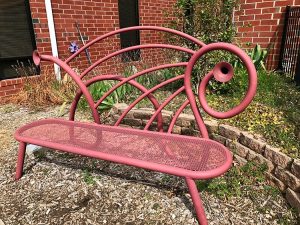 Madeline's passion and penchant for the arts run deep. Her brother, Mario Gallucci, holds a Master of Fine Arts in visual studies and lives in Portland, Oregon. Her father, Jim Gallucci, is an internationally acclaimed sculptor based in Greensboro. His large gateway pieces have transformed the Greensboro landscape, and Greensboro Montessori School is honored to have two of his “whisper benches” in the gardens flanking our front office. Madeline's mom is Dr. Kathy Gallucci, associate professor of biology at Elon University. Madeline shared she and her mom have a running joke that in their family, art is the dominant gene and science is the recessive gene. Art and science genes aside, if you saw the two side by side, you might actually wonder if they were twins.
Madeline's passion and penchant for the arts run deep. Her brother, Mario Gallucci, holds a Master of Fine Arts in visual studies and lives in Portland, Oregon. Her father, Jim Gallucci, is an internationally acclaimed sculptor based in Greensboro. His large gateway pieces have transformed the Greensboro landscape, and Greensboro Montessori School is honored to have two of his “whisper benches” in the gardens flanking our front office. Madeline's mom is Dr. Kathy Gallucci, associate professor of biology at Elon University. Madeline shared she and her mom have a running joke that in their family, art is the dominant gene and science is the recessive gene. Art and science genes aside, if you saw the two side by side, you might actually wonder if they were twins.
Like so many of our graduates, Madeline attended Greensboro Montessori School from the time she was a primary level student. “I was such an independent learner,” she said. “My parents knew that GMS was a good fit for me because I always had to do things in my own way and in my own time.” She further reflected on the values and life lessons from GMS that stick with her today. “Looking back, I realize how [the Montessori method] mirrored art school and also how it mirrors studio practice. There was always room for creativity and experimentation, and at the same time, I had to learn how to stay motivated and create my own structure and deadlines."

Madeline's work from DOUBLE TAKE, a 2016 exhibition at Terrault Contemporary in Baltimore, Maryland.
With Greensboro Montessori School's tuition payments dedicated to covering Greensboro Montessori School’s operating expenses, grants from the Annual Fund provide the necessary resources to make our School more than excellent - to make us truly exceptional. Through the benevolence of parents, alumni, community partners and friends of the School who give to the Annual Fund, Greensboro Montessori School is able to award grants biannually to teachers and students with specific classroom needs or transformative ideas or both!
Current year grants are funded by the previous year's giving. Contributions generously given and humbly received from last year's Annual Fund have begun taking shape through five grants awarded this fall. They range from simple classroom enhancements for our littlest students to significant technology investments for our elementary programs to supplies for creating a new ecosystem on campus (starring chickens) for our oldest scholars.
- Better Sleep for Growing Toddlers: The Academic-Day Toddler class received three new, high-quality Roman shades with blackout liners to help students get better sleep during nap time. While shades may seem simple to us, anything to promote sleep for our littlest students is transformative. The National Sleep Foundation says, "sleep is especially important for children as it directly impacts mental and physical development...During the deep states of [Non-Rapid Eye Movement] sleep, blood supply to the muscles is increased, energy is restored, tissue growth and repair occur, and important hormones are released for growth and development.
- Reading and Technology Resources for Lower Elementary: With four new Dell Chromebooks and a Raz-Kids subscription, the Lower Elementary program has increased access to age-appropriate, education-based technology. With dedicated laptops in the classroom, students will learn techniques for effective and safe online research and word processing skills. They will also be able to easily practice coding and have seamless access to their Raz-Kids online reading comprehension program. Furthermore, the use of PCs in Lower Elementary prepares students to be "bilingual" in the computer world. In many instances, we as adults use Apple products at home and PCs at work, or vice-versa, so ensuring our student have access to both platforms is important.
- iPads for Elementary Artists: In a continuation of Katherine Gwynn's exploration of the symbiotic relationship between creating with technology and hands-on art making, Greensboro Montessori School's art studio is now home to five iPad Airs and an iPad Pro. Students will integrate drawing, painting, digital photography, digital storytelling, animation and more through these new resources exclusive to our art curriculum.
- Chickens for Middle School Entrepreneurs: After 18 months of planning by students in the R&D (research and development) career track, the Middle School is developing a new ecosystem on campus for chickens. Working closely with Aubrey Cupit, Greensboro Montessori School's garden manager and owner of Gate City Harvest, Middle School students are building a mobile chicken coop, complete with a heat lamp, waterer and feeder for six chickens. Egg production will support the Land Lab, Maria's Café and other microeconomy programs. The coop will also include a technology cart with solar panels to power the coop's heat lamp. The mobile solar panels will also complement science lesson and provide a new power source at the Land.
- Ice for Bumps, Bruises, Food Prep, Entertaining and More: Until recently, we've been stocking our freezer with bags of ice. With a new industrial-grade ice maker, we've traded-out the ongoing cost of purchasing ice with a once-time cost to help us make it on our own (how Montessori of us)! The new ice maker supports the entire student-population ensuring a relatively unlimited supply of ice packs for minor student injuries. This resource will also keep our water and lemonade cold for guests at community events like the Fall Festival, Green & White Bash and End of the Year Pizza Party. Lastly, the Middle School will enjoy easy access to ice for Maria Café and trips to the Land.
Our fall grants are as varied as they are inspiring, but there are two things which bind them all. They are not only the result of giving, but also the reason for giving.
For everyone who has given in the past, is giving today or will give in the future, thank you for supporting Greensboro Montessori School. We are who we are because you have invested in us, and we promise to pay it forward by investing everything we can and all that we have in our students.
What do the oldest fabric in the world and a vintage typewriter have in common with my dentist? And what do they have to do with art? Well, I encountered each of them in the course of one week, and the intersection of these seemingly disparate things gave me an “a-ha” moment about the symbiotic relationship between creating with technology and hands-on art making in our School’s art studio.
As a mixed-media artist, I am naturally drawn to tactile, malleable, hands-on materials and adore using these materials in my lessons. If you walk into Greensboro Montessori School’s art studio, you will see a variety of rich textures, fibers, paints, clay, found objects and nature. You will also find a technology wall where one of the School’s 3D printers, a computers and iPads live. These two worlds co-exist harmoniously in our art studio and with each new day I am learning and teaching how technology and art are interwoven and applied in the world beyond the studio.
For instance, many Greensboro Montessori School faculty recently participated in an excellent coding workshop from Code.org. During this workshop I learned how coding is fun and creative and identified a great way to apply this technology in my classroom. Once armed with coding knowledge, students can practice their skills by writing an algorithm resulting in a specific design being drawn on their computer. They can bring this code to their art lesson and exchange it with another student. From there, students run each other’s algorithm to see if it produces what the creator originally intended.
Another project where technology and art intersect is stop motion animation. Students use a stop motion app on our classroom iPads to tell stories, but they also use physical objects make stop-motion animation the good old-fashioned way (by moving an object in small increments, taking photos of the object after each movement, and viewing multiple photos per second in a continuous sequence to create the illusion of motion). One of the most famous stop-motion animation films is the 1964 television special, Rudolph the Red-Nosed Reindeer. In our classroom, students manipulate KEVA planks, not wireframe figurines, to make their movies. The excitement has been great, and upper elementary students often rush back to class to ask Cathy Moses to come see their work!
Middle school students have been very helpful in teaching upper elementary students about the School’s 3D printer and 3D drawing program, SketchUp, which brings me back to my “a-ha” moment about the connection between art and technology. Within the course of one week at school I led a felting project demonstrating how to create with the oldest fabric in the world and guided lower elementary students in a freedom of speech exercise where they used a vintage typewriter to create art with their own words. I was reminded how each of these discoveries represented a technological shift at the time of their invention. At the end of the week, I went to the dentist and experienced a modern technology and art revolution in the making.
As crazy as it sounds, and as personal a story it is, my time at the dentist was real-world affirmation of the integration of art and technology. I was scheduled to get a crown and had anticipated my visit being the first of two required to complete the procedure, but then I was introduced to CAD/CAM (computer-aided design and computer-aided manufacturing) dentistry. While I was in the office, my dentist used technology to capture a 3D rendering of my tooth (CAD) and reproduce it onsite with a grinding and milling machine (CAM). While the grinding process used in my dentist’s office is different from the fabrication method used in 3D printing, the use of technology to produce sculpture in both cases highlights the inspirational interplay between technology and art. (And to top it all off, my ceramic crown was fired and glazed onsite, just like our students’ pottery is fired and glazed in our kiln!)
As we continue to create with our hands in collaborative and productive ways in Greensboro Montessori School's art studio, we will continue to grow the use of technology as well, because technology helps strengthen the development of our students 21st century skills and introduces them to career opportunities where art and technology co-exist.
“I fell in love with teaching again when I came to GMS."
The 2016-17 school year marks Sandra Lee’s fourteenth year of teaching Spanish at Greensboro Montessori School. For seven of those years she has been leading our 8th graders on their capstone experience end-of-year field trip to Costa Rica where they engage in a tremendous cultural exchange program with our sister school, the Summit Montessori School in San José. Through Sandra's stewardship, our Middle School students benefit from the unique opportunity to experience life immersed in a different culture, testing not only their language abilities but their capacity for adaptation, selflessness and citizenship.
While in Costa Rica, our students are paired with a host family and develop friendships with the middle school students at Summit Montessori School. Those formative relationships make lasting impressions on our students and help give them a deeper perspective of their role and responsibility as a global citizen. Sandra says, “What I love most about this program is that our students get to experience a very different reality and way of life when they are there. Plus, learning language has a lot to do with necessity, and while our students are in Costa Rica they may be staying with a host family that has very limited English. In those situations, their Spanish is essential.”
Sandra has taught students of all ages at Greensboro Montessori School. When she first started teaching to GMS in 2003, she taught Spanish in the Primary program. “I have never been more creative than when I taught at the Primary level because for children at that age, you have to be ready to adapt your lesson in a moment’s notice.” After a few years in Primary, she moved up to teach Spanish in Lower Elementary and then Upper Elementary. Now she is a leader and mentor for our team of Spanish faculty, including Susana D’Ruiz and Rossana Aranda, and thoroughly enjoys collaborating with her other colleagues while teaching in Upper Elementary and Middle School.
“One of the reasons I have loved working with Middle School is because of the strong relationships we end up having with our alumni. My former students often come back and tell me how much they are using what they learned in my classes. I know many GMS alumni who took Spanish 4 or Spanish 5 classes while they were in high school and their fluency is amazing."
Regarding the Spanish curriculum at GMS, Sandra says “since there is no specialized Montessori training for Spanish language teachers, over the years I have developed a hybrid Spanish curriculum that incorporates Montessori lessons together with more traditional teaching methods. I weave together web-based learning through a customizable web program called Conjugemos, textbook learning through Realidades (a traditional source also used in Guilford County Schools), and coordinated lessons with my Montessori colleagues. For instance, in Upper Elementary I work in tandem with the lead teachers to present Spanish lessons in geography and grammar right after the students have had the same lesson in English. It creates a greater context for their learning and makes it more relevant for the kids.”
Sandra holds a bachelor’s degree in English education from Universidad de Talca, Chile and always knew that she wanted to be a foreign language teacher. It is a funny coincidence that instead of teaching English to her fellow Chileans, now she helps the students of GMS immerse themselves in the language and culture of her home. But Sandra wasn’t always a Spanish language teacher. When she first moved to the United States in 1985, she worked as a technical translator and senior editor for AT&T and Lucent Technologies. How did she find GMS? Well, soon after her oldest daughter Isabella was born, Sandra began to explore preschool programs and landed at GMS at the recommendation of her extended family members whose children were already enrolled. Isabella enrolled in our Toddler program in 1998 and that was the beginning of Sandra’s journey with GMS. “I fell in love with teaching when I came to GMS,” says Sandra.
In a recent interview Sandra described GMS as a place that feels just like home. “The kids and my colleagues make me feel so good about myself and my work. The school has been a tremendous emotional support for me over the years and I really love teaching here. Everywhere I go in Greensboro, I see someone I know from my GMS family.”
This summer I've been introduced to Montessori Market, a summer camp Greensboro Montessori has offered for the last 17 years. Through a unique blend of environmental education and hands-on learning, campers participate in a week-long business preparing consumer goods for sale to the general public at the conclusion of camp. Just as our 2016 graduating class impressed me, Montessori Market has revealed yet another School tradition which is so much more than meets the eye.
Montessori Market is an all-hands-on-deck camp featuring contributions from the entire school community. Whatever produce we can't harvest from our own permaculture gardens, we source from local farmers. Both faculty and students work together to gather ingredients before camp even begins. This year, Nancy Hofer, Mary Jacobson, Kristy Ford and Andi Bogan chaperoned our Lower Elementary Al Fresco summer camp students to a local blueberry farm where they hand picked blueberries for jam. We also needed peaches which led me to think about The Produce Box, a service which delivers fresh produce from North Carolina farmers to my doorstep each week. After one quick trip to Raleigh and the overwhelming generosity of The Produce Box, we had boxes of peaches, certified organic zucchini, green bell peppers, corn, jalapeños and tomatoes.
The students began camp with a full refrigerator of fresh, North Carolina-grown produce and three sprawling gardens from which to pick fresh basil for pesto and lavender for sachets. They have also made a wide variety of handmade crafts to accompany their foodstuffs.
As the students approach the end of the week, the most beautiful and compelling aspect of camp comes alive. With finished goods ready for sale, you have to wonder, "for whom and to whom will they sell their goods, and where?" I've since learned that Montessori Market has always worked for the benefit of children in need. Campers wake up bright and early to sell their products at the Greensboro Farmers Curb Market on the Saturday immediately following camp, and all proceeds are donated to a charity focused on kids. Hence, it's time to introduce BackPack Beginnings.
Founded six years ago by Parker White, a new mother at the time, BackPack Beginnings' mission is to deliver child-centric services to feed, comfort, and clothe children in need in Guilford County. By ensuring food and basic necessities are given directly to children in need, BackPack Beginnings makes a positive and lasting impact on their health and well-being. As a 100% volunteer organization, BackPack Beginnings serves over 6,000 children experiencing hunger and trauma in our community annually. Recently, Parker has been named one of four finalists for The NASCAR Foundation’s Sixth Annual Betty Jane France Humanitarian Award presented by Nationwide. This award honors incredible volunteers from across the country who have made a profound impact on children’s lives in their community. (You can vote for Parker daily from now until September 26; if she wins, The NASCAR Foundation will make a $100,000 donation to BackBack Beginnings.)
Our Montessori Market campers have been learning, cooking, and collaborating on behalf of BackPack Beginnings all week. This Saturday, July 30, they will be at the Curb Market proudly displaying their finished goods, and a donation to BackPack Beginnings will allow market-goers to shop from their products. In addition to the pesto and sachets, shoppers may also select from blueberry jam, peach jam, salsa, zucchini bread, and a number of homespun crafts.
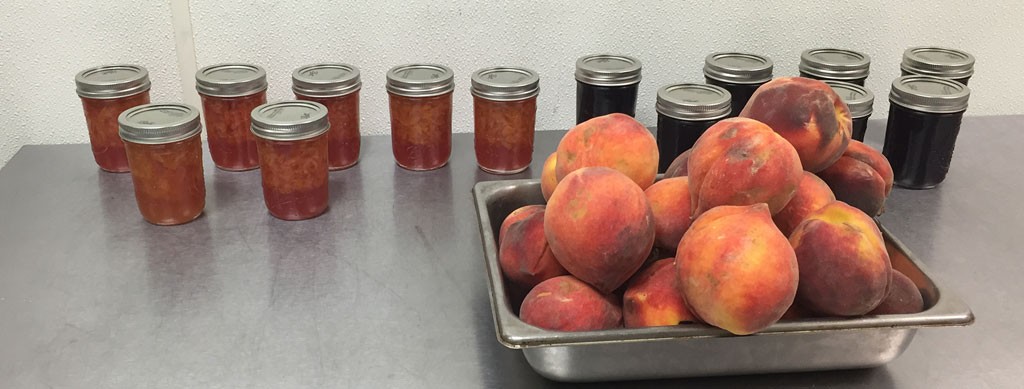
Peach and blueberry jams—lovingly made by students participating in Montessori Market—ready for display at the Greensboro Farmers Curb Market.
100% of the donations received on Saturday will assist the BackPack Beginnings' Food BackPack Program which helps fight childhood hunger in our community by filling the weekend food gap for children in need. By the numbers, this program sends 1,600 children from 26 schools with fresh food each weekend totaling 6,400 food bags per month. This effort is in addition to their Comfort BackPack, Food Pantry and Clothing Pantry programs. While our hope is that we receive enough donations on Saturday to empty our booth, any remaining products can be directly donated to BackPack Beginnings for direct inclusion in Food BackPacks or the Food Pantry.
So this is the story of how a summer camp evolves into so much more than a summer camp. How the Montessori philosophy challenges us, as adults, to push our kids to do more than text, snapchat and Netflix during summer break. How engaged faculty and community organizations prepare children for a lifetime of success by providing real-world experiences in running a business, manufacturing, time management, and philanthropy. And how children come together to help others less fortunate than themselves. And how Montessori Market is more than meets the eye.
GMS Student Art Show
Youth Art Month takes place annually, traditionally in March, to celebrate the value of art education for all children. Please join us in our celebration of the arts by attending the GMS Student Art Show & Reception on Tuesday, March 15 from 6:00 to 7:30 p.m. The art show is hosted by Mitchell & Bartlett Orthodontics, a true supporter of children's art and artists in the local community. Their office at 5314 West Friendly Avenue. This is the third year in a row that they have hosted a GMS art show. Thanks to Dr. Kelly Mitchell and her mother Sharon for being such gracious hosts.
These are just a few of the artists in Lower Elementary that will be exhibiting their work.
Lower Elementary Self Portraits
Imagination is more important than knowledge. - Albert Einstein
Upper Elementary Illuminations
Upper elementary art students have been using their art studio time to work on scenery for Medieval Faire Fare performance on Wednesday, March 23. As a result these talented artists will not be exhibiting a lot of their art work at the show. You can look forward to their art work displayed at the performance. Take a look at their Medieval illuminations they created in art.

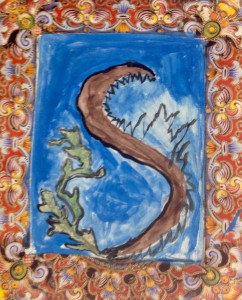
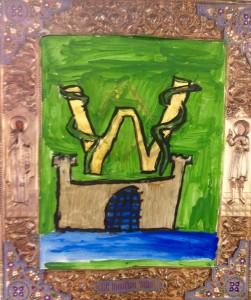
Primary Art
Primary students enjoy taking their art home right upon completion, therefore they will not have their work displayed at the art show. However, please frequent the gallery hall located outside the front office to view some of their latest printmaking works.


